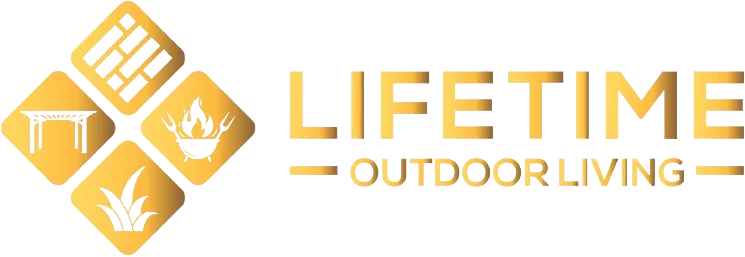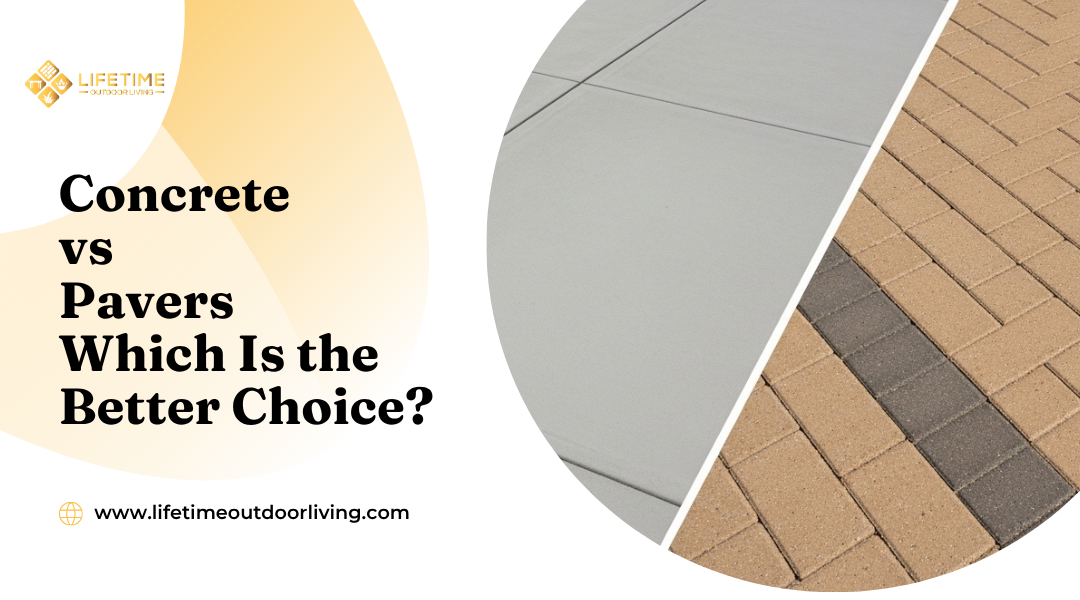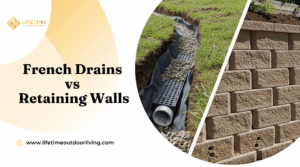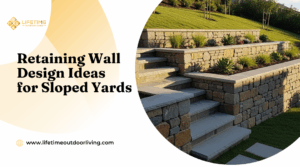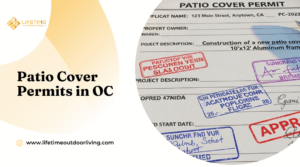Choosing the right driveway material for your Orange County home impacts both your property’s curb appeal and long-term maintenance costs. With the region’s unique climate conditions, traffic patterns, and architectural styles, homeowners face a critical decision between two popular options: traditional concrete and decorative pavers.
For most Orange County driveways, pavers offer superior design flexibility and better performance in the region’s climate, while concrete provides a more budget-friendly upfront investment. Each material brings distinct advantages depending on your specific needs, budget, and aesthetic preferences.
This comprehensive comparison examines cost factors, durability in Orange County’s conditions, maintenance requirements, and design potential to help homeowners make an informed decision. The analysis includes expert insights on how each material performs under local weather patterns, soil conditions, and the demands of California outdoor living.
Why Your Driveway Choice Matters In Orange County
Orange County homeowners face unique considerations when selecting driveway materials that can significantly impact both property values and long-term performance. The region’s climate conditions and real estate market create specific challenges that make material selection particularly important.
How Driveway Materials Affect Curb Appeal And Home Value
Driveway materials directly influence a property’s market value in Orange County’s competitive real estate environment. Pavers typically provide higher returns on investment compared to standard concrete driveways.
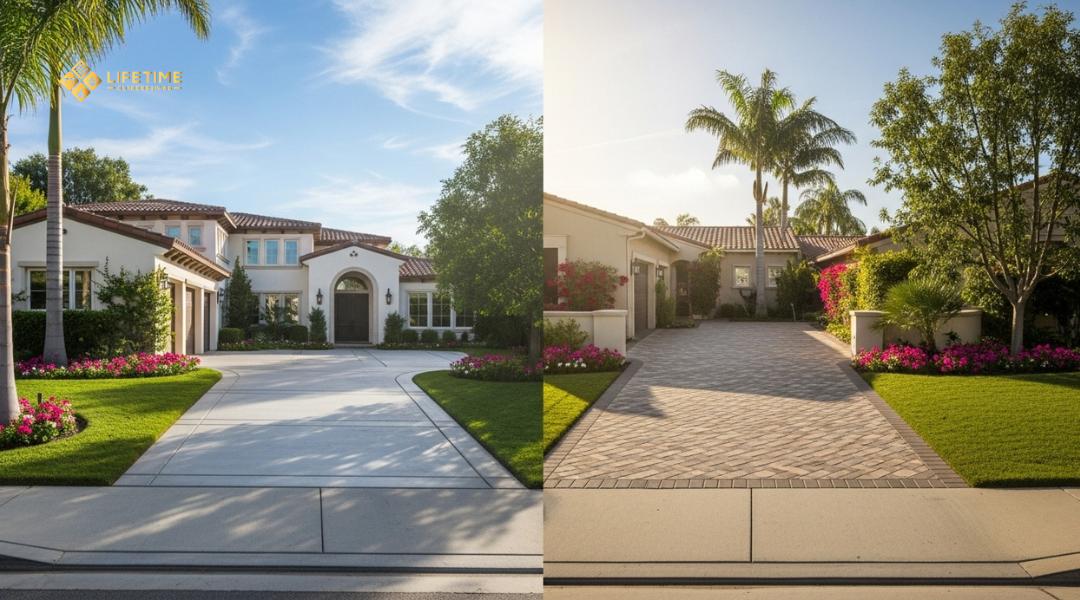
Premium materials offer distinct advantages:
- Pavers can increase home value by 7-10%
- Concrete driveways provide 5-7% value increases
- Custom designs attract quality buyers
The visual impact extends beyond monetary considerations. Pavers allow homeowners to create distinctive patterns and color combinations that complement Mediterranean and contemporary architectural styles common throughout Orange County.
Concrete driveways offer clean, uniform appearances that appeal to buyers seeking low-maintenance options. However, they provide limited customization opportunities compared to paver installations.
Curb appeal factors include:
- Material texture and finish quality
- Color coordination with home exterior
- Design complexity and craftsmanship
- Overall maintenance condition
Real estate professionals in Orange County consistently report that upgraded driveway materials help properties stand out in listings and attract serious buyers willing to pay premium prices.
Climate, Soil, And Coastal Factors That Impact Durability
Orange County’s Mediterranean climate creates specific challenges for driveway materials. Temperature fluctuations between hot summers and mild winters cause expansion and contraction cycles.
Climate considerations include:
- Minimal freeze-thaw damage risk
- High UV exposure from intense sunlight
- Occasional heavy rainfall periods
- Salt air exposure near coastal areas
Coastal proximity affects material performance differently. Salt air accelerates concrete deterioration through chemical reactions with embedded metals and surface compounds.
Pavers handle coastal conditions better due to individual unit construction. If damage occurs, homeowners can replace specific pavers rather than entire sections.
Soil conditions vary significantly across Orange County:
- Clay soils in inland areas cause settling
- Sandy coastal soils provide better drainage
- Expansive soils require proper preparation
- Seismic activity demands flexible materials
Pavers accommodate ground movement more effectively than monolithic concrete slabs. Their segmented design allows for minor shifts without visible cracking or structural compromise.
Concrete Driveways: Pros, Cons, And Best Uses
Concrete driveways offer a cost-effective solution with excellent durability for Orange County’s climate. While they provide strong structural performance and low maintenance requirements, concrete surfaces face limitations in design flexibility and potential cracking issues.
Advantages Of Concrete In Orange County
Concrete driveways excel in Orange County’s Mediterranean climate due to their exceptional durability and heat resistance. The material withstands temperature fluctuations without significant expansion or contraction issues.
Cost efficiency makes concrete attractive for homeowners. Installation costs typically range 30-50% less than comparable paver systems. The straightforward installation process reduces labor expenses significantly.
Concrete requires minimal ongoing maintenance compared to other driveway materials. Regular cleaning and occasional sealing every 2-3 years keeps surfaces in optimal condition.
Structural strength allows concrete to support heavy vehicles without damage. The solid surface distributes weight evenly, preventing rutting or displacement common with loose materials.
Concrete driveways offer excellent longevity when properly installed. Well-maintained concrete surfaces can last 25-30 years in Orange County’s climate conditions.
Common Drawbacks And Maintenance Challenges
Cracking represents the primary concern with concrete driveways in Orange County. Soil movement, tree roots, and settling can create visible cracks that require professional repair.
Limited design options restrict aesthetic customization. Standard concrete provides fewer color and pattern choices compared to pavers or decorative alternatives.
Oil stains and tire marks appear more prominent on concrete surfaces. These stains penetrate the porous material and prove difficult to remove completely.
Concrete repairs often create visible patches that don’t match the original surface perfectly. Replacing damaged sections requires cutting and removal of substantial concrete areas.
Heat absorption makes concrete surfaces uncomfortably hot during Orange County’s summer months. The material retains heat longer than alternatives like pavers with joint spacing.
Concrete driveways show wear patterns more readily than textured alternatives. Heavy traffic areas develop smooth, polished sections that can become slippery when wet.
Ideal Situations For Choosing Concrete
Budget-conscious homeowners benefit most from concrete driveway installation. Projects with strict financial constraints find concrete provides maximum value per square foot.
Large driveways suit concrete particularly well due to cost advantages on extensive areas. The material covers significant spaces efficiently without complex installation requirements.
Properties with heavy vehicle usage should consider concrete for its load-bearing capacity. Commercial vehicles, RVs, and boats require the structural support concrete provides.
Homeowners prioritizing low maintenance find concrete appealing for busy lifestyles. The surface requires minimal ongoing care beyond periodic cleaning and sealing.
Straight, geometric driveway layouts work well with concrete’s natural characteristics. Simple rectangular or curved designs complement concrete’s streamlined appearance effectively.
Properties without significant tree coverage avoid concrete’s main weakness of root damage. Open areas with stable soil conditions provide ideal installation environments.
Paver Driveways: Pros, Cons, And Best Uses
Paver driveways offer exceptional design flexibility and durability for Orange County homes, though they require higher upfront investment and regular maintenance. They excel in areas with settling soil and where aesthetic appeal takes priority over initial cost.
Advantages Of Pavers In Orange County
Pavers provide superior design versatility compared to concrete slabs. Homeowners can choose from brick, concrete, or natural stone pavers in dozens of colors, patterns, and textures.
Durability benefits include excellent performance in Orange County’s earthquake-prone environment. Individual pavers flex with ground movement without cracking like solid concrete surfaces.
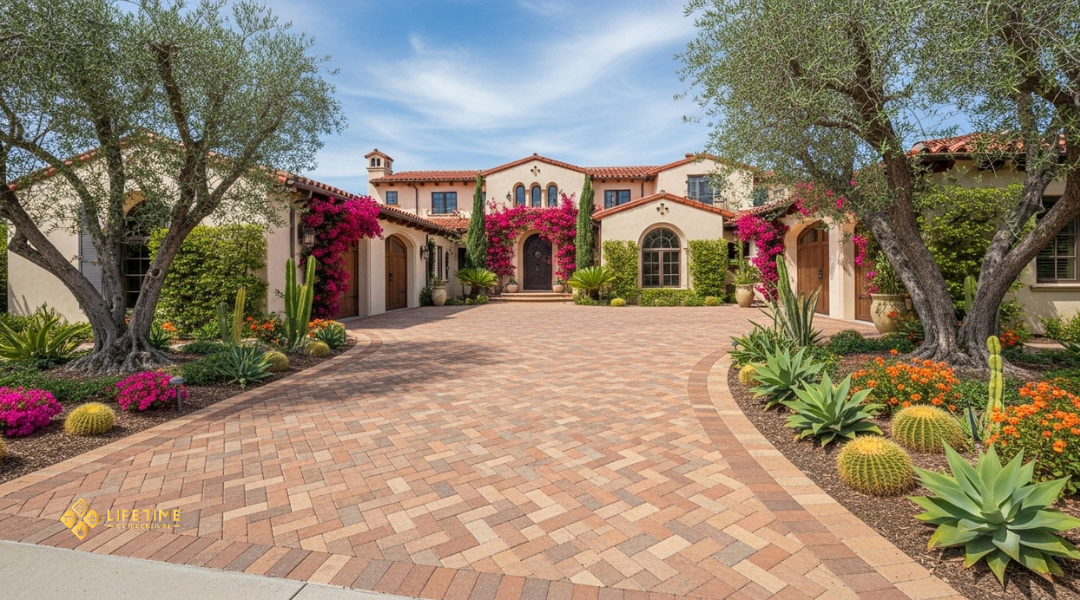
The installation process allows for immediate repairs. Damaged pavers can be lifted and replaced individually without affecting surrounding areas. This proves valuable for utility access or tree root damage.
Weather resistance stands out in Orange County’s climate. Pavers handle temperature fluctuations better than concrete. They resist cracking from thermal expansion and contraction.
Surface texture provides enhanced traction during rare rainfall events. The joints between pavers create natural drainage channels that reduce water pooling.
Property values typically increase more with paver installations. Real estate studies show paver driveways add 7-10% more resale value than standard concrete in premium neighborhoods.
Potential Drawbacks And Cost Considerations
Initial installation costs range from $12-25 per square foot in Orange County. This represents 2-3 times the expense of poured concrete driveways.
Labor requirements drive much of the cost difference. Proper paver installation demands excavation, base preparation, sand leveling, and precise placement of each unit.
Maintenance demands exceed concrete requirements. Weeds grow between joints without proper sealing. Sand bedding requires periodic replenishment after heavy rains.
Joint sand migration creates ongoing upkeep. Homeowners must refill and compact sand every 2-3 years to prevent paver shifting.
Staining challenges vary by material type. Concrete pavers absorb oil stains more readily than sealed surfaces. Natural stone pavers may require specialized cleaning products.
Snow removal proves difficult in rare Orange County snow events. Plow blades can catch paver edges and dislodge units from their bedding.
Ideal Situations For Choosing Pavers
Hillside properties benefit most from paver installations. The flexible surface accommodates soil movement and settling without structural damage.
Homes with mature landscaping see advantages from easy repair access. Tree roots can lift individual pavers without requiring full driveway replacement.
Custom home projects where design flexibility justifies premium costs. Pavers complement architectural styles from Mediterranean to contemporary designs.
Properties with drainage challenges perform better with permeable paver systems. These allow water infiltration between joints rather than surface runoff.
High-end neighborhoods where curb appeal impacts property values significantly. The premium appearance helps maintain competitive resale positioning.
Areas requiring frequent utility access benefit from removable paving surfaces. Gas, electric, or cable repairs become simple without concrete cutting or patching.
Cost Comparison: Concrete Vs Pavers In OC
Concrete typically costs $6-15 per square foot installed, while pavers range from $10-30 per square foot in Orange County. However, maintenance expenses and longevity factors significantly impact the true cost difference over time.
Upfront Installation Costs
Basic concrete installation in Orange County ranges from $6-12 per square foot for standard applications. Decorative concrete with stamping, coloring, or special finishes increases costs to $12-18 per square foot.
Paver installation costs $15-25 per square foot for standard materials like concrete pavers. Natural stone pavers can reach $25-35 per square foot installed.
Labor costs account for 40-60% of total project expenses. Concrete requires skilled finishing work but faster installation. Paver projects demand more time for precise placement and base preparation.
Material costs favor concrete significantly. A 500 square foot driveway costs $3,000-6,000 in concrete versus $7,500-12,500 in pavers before installation.
Permit fees in Orange County range $200-500 for both materials. Site preparation costs remain similar, typically $2-4 per square foot for proper excavation and base work.
Long-Term Maintenance And Repair Expenses
Concrete driveways require sealing every 2-3 years at $0.50-1.50 per square foot. Crack repairs cost $300-800 per incident, depending on severity and extent.
Concrete challenges include inevitable cracking from ground movement and temperature changes. Staining from oil or rust requires professional cleaning at $200-400 per treatment.
Pavers need occasional re-sanding of joints every 3-5 years at $1-2 per square foot. Individual damaged pavers cost $5-15 each to replace, including labor.
Paver advantages include easy spot repairs without affecting surrounding areas. Power washing costs $150-300 annually but effectively maintains appearance.
Sealing costs for pavers run $2-4 per square foot every 5-7 years. This optional treatment enhances color retention and stain resistance.
Total Cost Of Ownership Over 10–20 Years
A 500 square foot concrete driveway costs approximately $4,000-7,000 initially. Maintenance expenses add $2,000-4,000 over 20 years, totaling $6,000-11,000.
Concrete replacement becomes necessary after 15-25 years due to extensive cracking or surface deterioration. Full replacement costs match initial installation prices.
The same paver driveway costs $8,000-13,000 upfront. Maintenance expenses range $1,500-3,000 over 20 years, totaling $9,500-16,000.
Paver longevity extends 25-40 years with proper maintenance. Individual repairs prevent complete replacement needs in most cases.
Property value impact favors pavers, adding 5-10% more resale value than concrete. This premium often offsets the higher initial investment for Orange County homeowners.
Climate considerations in Orange County’s mild weather reduce freeze-thaw damage for both materials, extending lifespan compared to harsher climates.
Durability And Maintenance In OC Conditions
Orange County’s Mediterranean climate presents unique challenges with intense UV exposure, temperature fluctuations between 40-90°F, and coastal salt air that affects both concrete and paver durability differently. Each material requires specific maintenance approaches to maximize lifespan in these conditions.
How Each Material Handles Heat, UV, And Coastal Air
Concrete expands and contracts significantly with Orange County’s temperature swings. The material absorbs heat during summer days, reaching surface temperatures of 120°F or higher.
UV rays cause concrete sealers to break down within 2-3 years. This leads to surface deterioration and increased porosity.
Coastal salt air penetrates concrete through microscopic pores. The chlorides cause internal corrosion and surface spalling over time.
Pavers handle thermal expansion better due to joint spacing. Individual units move independently, reducing stress concentration.
The dense composition of quality concrete pavers resists UV degradation. Most pavers maintain color stability for 15-20 years without significant fading.
Salt air affects paver joints more than the pavers themselves. Proper joint sand selection prevents salt buildup and maintains structural integrity.
Crack Prevention, Repairs, And Replacement Options
Concrete Crack Management:
- Control joints every 8-10 feet reduce random cracking
- Hairline cracks require immediate sealing to prevent water infiltration
- Major repairs involve cutting out damaged sections and patching
Concrete repairs rarely match the original surface color or texture perfectly. Large cracks often return due to underlying movement issues.
Paver Repair Advantages:
- Individual damaged pavers can be removed and replaced
- Repairs blend seamlessly with existing installation
- No curing time required for immediate use
Settlement issues affect isolated areas rather than entire surfaces. Releveling involves lifting affected pavers, adjusting base material, and reinstalling.
Cleaning And Seasonal Care Tips
Concrete Maintenance Schedule:
- Power wash every 6 months to remove salt and debris buildup
- Apply penetrating sealer every 2-3 years
- Address oil stains immediately with degreasing agents
Efflorescence appears frequently in coastal areas. Regular cleaning with mild acid solutions removes white salt deposits.
Paver Care Requirements:
- Sweep joints monthly to prevent weed growth
- Reapply joint sand annually after cleaning
- Seal pavers every 3-5 years depending on traffic
| Maintenance Task | Concrete | Pavers |
|---|---|---|
| Deep cleaning | Bi-annually | Annually |
| Sealing frequency | 2-3 years | 3-5 years |
| Stain removal | Difficult | Moderate |
| Winter prep | Inspect for cracks | Check joint sand levels |
Pressure washing pavers requires lower PSI settings to avoid joint sand displacement. Use polymeric sand in high-traffic areas for better joint stability.
Design And Customization Potential
Concrete offers several finish options and color choices, while pavers provide extensive variety in patterns, materials, and layouts. Both materials can complement different architectural styles when selected thoughtfully.
Finish And Color Options For Concrete
Standard concrete driveways come in basic gray, but modern techniques expand design possibilities significantly. Stamped concrete creates patterns that mimic brick, stone, or tile surfaces.
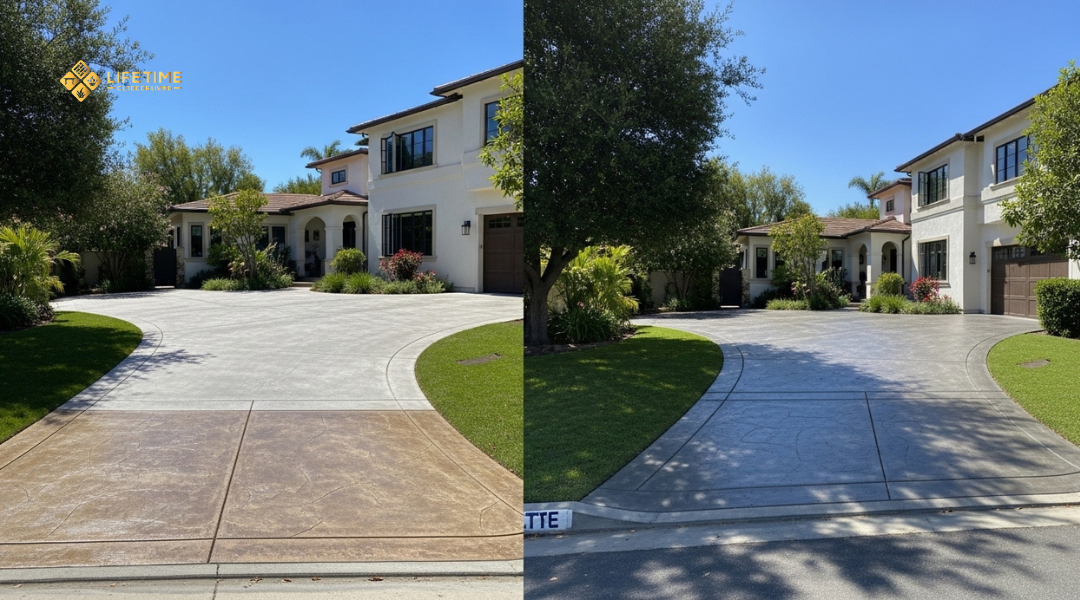
Color options include integral coloring mixed into the concrete or surface-applied color hardeners. Popular choices range from earth tones like tan and brown to bolder options like red or blue.
Texture finishes add visual interest and functionality. Broom finishes provide slip resistance, while exposed aggregate reveals decorative stones within the concrete mix.
Acid staining creates unique mottled effects and color variations. This technique works best on smooth concrete surfaces and produces organic-looking patterns.
Border treatments can define edges with contrasting colors or stamped patterns. These details help break up large concrete expanses and add visual appeal.
Patterns, Borders, And Styles With Pavers
Pavers offer the highest level of design customization for driveways. Material choices include concrete pavers, clay brick, natural stone, and porcelain options.
Popular patterns include herringbone, basket weave, running bond, and circular designs. Herringbone provides excellent interlock strength while creating visual movement.
Color combinations allow homeowners to create borders, accents, or geometric designs. Mixing two or three complementary colors prevents overwhelming the space.
Size variations add texture and interest. Combining large and small pavers creates dynamic layouts that work well with contemporary architecture.
Border treatments define the driveway edges and transition to landscaping. Contrasting colors or soldier course borders provide clean, finished appearances.
Natural stone pavers like travertine or flagstone offer unique textures and color variations. These materials complement Mediterranean and rustic architectural styles particularly well.
Matching Your Driveway To Your Home’s Architecture
Traditional homes benefit from classic brick pavers or stamped concrete that mimics cobblestone. These materials complement colonial, craftsman, and tudor architectural styles.
Modern homes pair well with large-format concrete pavers in neutral colors. Smooth concrete with minimal texture maintains clean, contemporary lines.
Mediterranean styles work best with natural stone pavers or warm-colored concrete. Terra cotta and earth tone color palettes enhance these architectural themes.
Color coordination should consider roof materials, exterior paint, and existing hardscaping. Neutral tones provide flexibility for future exterior updates.
Scale considerations matter for proportion. Large properties can handle bold patterns and contrasting colors, while smaller driveways benefit from simpler designs.
The home’s existing materials guide appropriate choices. Stone accents on the house exterior suggest natural stone pavers, while stucco exteriors complement concrete options.
Environmental And Drainage Considerations
Pavers offer superior stormwater management through permeable surfaces that reduce runoff by up to 90%. Orange County’s strict drainage regulations favor permeable surfaces over traditional concrete for new driveway installations.
Permeable Pavers Vs Traditional Concrete
Permeable pavers allow water to filter through joints and into the ground below. This natural drainage system prevents water pooling and reduces strain on municipal storm systems.
Traditional concrete creates an impermeable barrier that forces water to run off into streets and storm drains. A typical concrete driveway directs 100% of rainfall away from the property.
Water infiltration rates:
- Permeable pavers: 5-10 inches per hour
- Traditional concrete: 0 inches per hour
- Porous concrete: 2-8 inches per hour
Pavers reduce the heat island effect by allowing air circulation through joints. Concrete absorbs and retains heat, contributing to higher ambient temperatures around homes.
The production of concrete requires significant energy and releases carbon dioxide. Pavers use less energy during manufacturing and can be reused or recycled when removed.
Local Stormwater And Runoff Regulations
Orange County requires Low Impact Development (LID) compliance for new residential projects exceeding 2,500 square feet of impervious surface. Driveways often trigger these requirements for single-family homes.
The county mandates that developments retain the first 0.75 inches of rainfall on-site. Permeable paver driveways help meet this requirement without additional retention systems.
Current LID requirements include:
- On-site stormwater retention
- Reduced peak flow rates
- Water quality treatment measures
- Native landscaping integration
Traditional concrete driveways may require expensive drainage infrastructure like French drains or retention basins. These systems add $3,000 to $8,000 to project costs.
Permeable pavers qualify for green building credits and may reduce permit fees in some Orange County jurisdictions. The county offers expedited permitting for projects incorporating sustainable drainage solutions.
Lifetime Outdoor Living’s Expert Recommendation
The company evaluates multiple property-specific factors before recommending concrete or pavers for Orange County driveways. Their approach often includes innovative hybrid solutions that maximize the benefits of both materials while addressing individual client needs.
Factors We Consider When Guiding Clients
Property slope and drainage represent primary considerations in material selection. Pavers excel on sloped driveways because individual units can shift slightly without cracking. Concrete requires precise grading and drainage systems to prevent water pooling and freeze-thaw damage.
Soil conditions directly influence foundation requirements. Orange County’s clay-heavy soils expand and contract seasonally. Pavers accommodate this movement through flexible joints, while concrete may develop stress cracks over time.
Budget allocation extends beyond initial installation costs. The team analyzes:
- Upfront material and labor expenses
- Long-term maintenance requirements
- Potential repair costs over 15-20 years
Design preferences shape the final recommendation. Clients seeking uniform, modern aesthetics often prefer concrete. Those wanting varied textures, colors, or patterns typically choose pavers.
Maintenance capacity affects material suitability. Busy homeowners may prefer concrete’s minimal upkeep. Clients who enjoy landscaping projects often select pavers for their hands-on maintenance opportunities.
Hybrid Solutions That Combine Concrete And Pavers
Concrete base with paver accents creates cost-effective visual interest. The main driveway uses stamped or colored concrete, while paver borders or geometric insets add decorative elements. This approach reduces material costs by 30-40% compared to full paver installation.
Paver strips in concrete driveways provide practical benefits beyond aesthetics. Strategic paver placement creates natural expansion joints that prevent concrete cracking. These strips also define parking areas or traffic lanes.
Transition zones blend materials seamlessly. Pavers near the house entrance create welcoming focal points, while concrete handles high-traffic vehicle areas. This combination balances durability with curb appeal.
Functional material placement optimizes performance characteristics. Pavers work well in areas requiring frequent access to utilities. Concrete serves high-load zones like RV parking or turning areas where heavy vehicles create stress concentrations.
